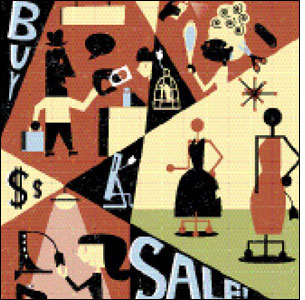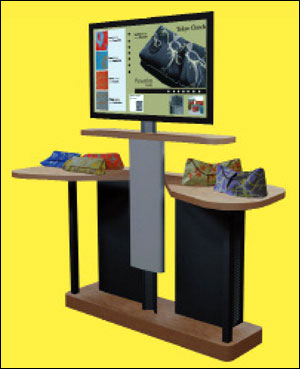Presented below is part seven of an 11-part series examining the use of radio frequency identification for unexpected applications. In this chapter, we consider RFID’s use in the customer-service industry.
56. Mirror, Mirror on the Wall
Several high-end apparel retailers—including Mi-Tu in Hong Kong, Industry Standard in Columbus, Ohio, and Nick Tentis Living Retail Theatre in London—have introduced “magic mirrors.” The RFID-enabled mirror reads the tags on clothing shoppers are trying on, and then displays product information, such as available sizes and colors in stock, and appropriate accessories. (See Hong Kong Shoppers Use RFID-Enabled Mirror to See What They Want, Magicmirror Could Assist Retail Customers, To Glimpse RFID’s Future Down Under, Gaze Into the EPCmagic Mirror and Disney Gets It.)
|
|
57. Window Shopping
Krause Outlet, a German retailer, operates a 24-hour automated fashion show in store windows. High-end articles of clothing move on automated hanging racks. As each tagged garment reaches the window, the rack stops and turns that item around 180 degrees. A nearby RFID interrogator reads the tag attached to the garment and displays information about the item on a computer screen in the store window. Customers can use their mobile phones to call an automated hotline to purchase the item or put it on hold. (See Krause Outlet Takes Window-Shopping to the Ultimate Level.)
58. Smart Supermarket Carts
Shopping wagons equipped with RFID devices can communicate with readers or tags installed throughout a grocery store. Some carts, such as those used at a supermarket in Park City, Utah, provide customers with coupons, prizes and promotional materials. Other carts draw maps to show shoppers quick routes to items they can’t find. (See Mobile RFID Device for Shoppers Boosts Store Sales and Spotlight on Five Hot Apps.)
59. An Out-of-Store Experience
Shoppers at Fly London, an upscale shoe and accessory retailer in Lisbon, Portugal, can see how they’ll look wearing the merchandise on the busy streets of Tokyo, London or New York. The store features an RFID-enabled floor that reads the tagged shoes a customer is wearing and instructs a video system to display her image on a flat screen. The virtual trip is fun for customers, and the RFID system helps the company avoid out-of-stocks. (See Fly London Uses RFID to Manage Inventory, and Take Customers Around the World.)
60. Meet and Greet
Yes Bank, in India, issues RFID-enabled cards to wealthy clients. A client’s card is read as the individual enters the bank, and a photo and information about the client pops up on a screen so employees can greet the customer by name and ensure prompt service. Mercedes Benz of Buckhead, in Atlanta, also uses an RFID system to identify customers and their vehicles when they come in for maintenance or repairs. The system alerts employees when a customer arrives, and moves that person’s car through the service process more quickly. (See Yes Bank Uses RFID to Personalize Service and RFID Delivers Personal Service for Atlanta Car Dealer.)
61. Hands-On
At MainStreet America, a theme park in Houston scheduled to open in spring 2012, visitors will be able to peruse 12 completely furnished homes, and use RFID-enabled tablet PCs to learn more about thousands of tagged items within and around the buildings. Product videos and information, including pricing and installation details, will be displayed on screens. The system will store items of interest, so after the shopper’s “self-guided tour,” a staff member can provide additional information about a specific product, set up a payment plan, execute a purchase and arrange a delivery. (See Home-Shopping Theme Park to Employ RFID.)
62. Personal Shoppers
Both Clothing for a Better Earth, in Syracuse, N.Y., and Staff Jeans, in Athens, Greece, invite customers to check in and receive RFID-enabled devices, so they can receive specific garment suggestions as they browse tagged merchandise. Information appears on in-store video screens or on the devices. At both stores, the personal-shopping solution works with other RFID systems. At Clothing for a Better Earth, RFID is integrated with the store’s point-of-sale system, so purchased items are automatically removed from inventory. And Staff Jeans employs RFID to automate check out and authenticate items for returns. (See Organic Clothing Retailer Makes Shopping Personal and Staff Jeans to Introduce RFID-Enabled Customer Services.)
63. Cashless Shopping
In La Junta, Colo., the locals refer to their payment transactions as “Blinging.” The term comes from a new contactless payment application provided by California payments network startup Bling Nation, in conjunction with The State Bank and Viaero Wireless, a mobile-phone service provider. It lets folks employ an adhesive RFID label attached to their mobile phones to pay for purchases at some 60 area merchants. The transaction cost is deducted from their bank accounts. (See Colorado Town Goes Contactless.)
64. Up Close and Personal
Whether it’s cosmetics, sunglasses or wine, RFID-enabled kiosks let customers access a wealth of information about the tagged merchandise on display. By simply picking up an item, consumers activate a video or touch screen to view product specifics. (See Estée Lauder Interacts With Customers Via RFID, RFID Makes Common People an Uncommon Store, Interactive Wine Kiosk Wows Customers and Mitsukoshi and Shiseido Test Tagged Cosmetics.)
65. Virtual Sales Assistants
Penumbra Textile, a fabrics designer and supplier, in Barrington, N.H., plans to use an RFID-based video system to give shoppers looking for decoration and clothing materials a more appealing array of choices. The InMotion Retail Marketing system, from Pittsfield ID Technologies, in Pittsfield, N.H., features a display for products and a nearby touch screen. When a shopper picks up a tagged item, the system triggers a sales presentation or product demonstration. It is designed to boost sales and generate a wealth of marketing data.
“We want to know what people are looking at,” says Sarah Camp, Penumbra Textile’s director of marketing. “We’re looking at what colors are next, what product is best. There are a lot of variables, and this tool is going to help us nail them down.”
To activate the system, a customer just has to pick up a tagged item. “We’re not asking someone to bring an RFID tag or a tagged product close to a reader… We’re actually flooding the area with RF signal,” says Frederick Bleckmann, Pittsfield ID’s VP of development. “Our main focus has been on how we can bring RFID to the store floor and the customer to really use it to help sell things.”
In addition to product manufacturers like Penumbra, several retailers—including a major apparel and outdoor sports equipment company and a large electronics retailer (both of which asked not to be named)—plan to deploy the system this year. “Someone walks into a store to look at digital cameras and, as they do so, they pick them up,” Bleckmann says. “It’s one of those items you want detailed, on-demand information about.
“We’re able to adjust the sensitivity so the system focuses on the item the customer is demonstrating they’re interested in by their behavior,” he adds. “If someone shuffles through a bunch of shoes or clothes, you don’t want to trigger a whole bunch of ads.”
Add-on technologies help enrich the data flow. “We added video recognition so we’re able to make a guess at the shopper’s age and make an accurate guess at the gender of the shopper,” Bleckmann says. The system can also estimate the number of shoppers passing by a display, as well as spot people who stop to look without touching any merchandise—”if someone turns their head toward the viewing area to look at the screen,” he explains.
“The marketing data portion of this system is immensely popular,” Bleckmann says. “We always envisioned it being a very important piece of what retailers were interested in, but after getting the product to market, I think we underestimated how valuable the in-depth data is that we are able to provide.”
Marketing data aside, Camp notes that InMotion gives consumers the best of both retail worlds: Internet-style information delivery combined with a real-world hands-on shopping experience. “There’s a difference between seeing fabric in a picture and holding it in your hands,” she says.
Click here to read about RFID’s use in other unexpected applications.
Illustration: iStockphoto



